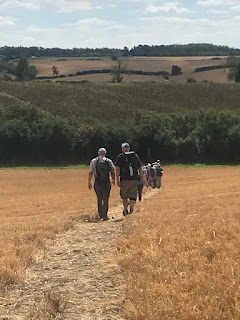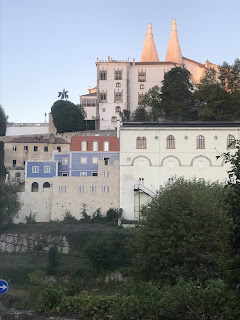What is a Pilgrimage - Part One
Part
1
25/72022
A
traditional pilgrimage is a journey usually taken on foot to a place of
religious significance. Pilgrims of all faiths have walked for centuries, to
places such as Mecca, Canterbury, The Vatican and the Golden Temple. On a visit
to India in 2007, whilst travelling in a minibus in the middle I found my self
caught up in a pilgrimage of thousands of people walking, many barefoot and
carrying their possessions in a couple of plastic bags. The minibus crawled for
hours through the throng. As night fell, we came to feeding stations where the
village people served the pilgrims daal, vegetable curry and chapattis from
giant dishes on gas cylinders onto banana leaf plates which littered the floor
but were completely biodegradable. The pilgrims then lay down and slept on the
floor. Earlier in the day I needed to use the toilet and was told I would have
to go in the fields. Our guide was worried that as a western woman as soon as I
stepped out of the minibus I would attract a lot of attention, so I was wrapped
in a dupatta around my head and another around my body before scurrying into a
golden wheat field where I was able to squat in peace for a few moments like
everyone else did on this road.
The
gift of support and sustenance provided by these villagers is matched on the
Camino de Santiago by the Refugio’s run by the monasteries or local councils
where a modest donation is made. On my first mini-Camino in 2018, a few minutes
after we heaved our rucksacks onto our backs, having got off the bus to our
starting point, we were gazing at our map wondering which way to go and were
offered a lift by a woman in a car. We politely declined as it would have been
just too ironic to accept but were glad of the directions, she was able to
offer.
Whilst
walking I met people and shared stores. I came across an Irish woman in her 70s
walking with her husband and friends. She was at the back of her group and I
fell into step beside her as the others moved ahead. She walked with two walking
poles and was struggling. She told me of her life looking after her son who was
now supported by a care team in a small house. She was walking because she now
had the freedom to do it and the journey for her was partly about giving thanks
for his life and what he had given her. At the end or our journey, we met again
at the pilgrim’s service. One of her group told me of the enormous blister on
her friend’s foot and how astonished she was that she could have walked on it
and completed the journey.
From
these experiences I learned about the devotion, simplicity, determination, kindness,
and camaraderie of pilgrimage.





Comments
Post a Comment